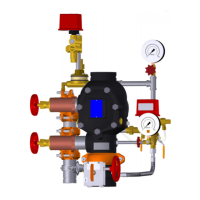I-769N.Preaction/AC-ELEC / Victaulic
®
Series 769N FireLock NXT
™
/ Installation, Maintenance, and Testing Manual
TROUBLESHOOTING – SYSTEM
Problem Possible Cause Solution
The valve operates without sprinkler activation. There is a loss of air pressure in the system or trim. Check for any leaks in the system and trim. Conrm that the AMTA is
operating properly. Consider installing a low-air supervisory switch.
The pressure switch on the air compressor is set too low, or the compressor
is not operating properly.
Increase the “ON” setting of the air compressor’s pressure switch, and check
the air compressor for proper operation.
Water is leaking from the ball drip on the alarm manifold
assembly.
Water is getting past the clapper seal and into the intermediate chamber
of the valve.
Check the clapper seal and valve body seat ring for physical damage and
foreign material.
Water is under the clapper seal. Inspect the clapper seal to ensure that no water is under the seal. If water is
present, remove and replace the seal. Refer to the “Removing and Replacing
the Clapper Seal” section.
Air is leaking from the ball drip on the alarm manifold assembly. Air is getting past the clapper seal and into the intermediate chamber of
the valve.
Check the clapper seal and valve body seat ring for physical damage and
foreign material.
Water is under the clapper seal. Inspect the clapper seal to ensure that no water is under the seal. If water is
present, remove and replace the seal. Refer to the “Removing and Replacing
the Clapper Seal” section.
The clapper will not latch closed. There is no water pressure on the diaphragm. Check the water pressure in the charge line. Ensure that the restrictor in the
charge line is clean.
Verify that the manual pull station valve is closed.
Verify that the solenoids are closed (de-energized).
The auto drain is not set. Set the auto drain by pulling up on the auto drain sleeve.
Water is leaking from the diaphragm assembly. The diaphragm is damaged. Contact Victaulic.
Air is leaking from the diaphragm assembly. The diaphragm is damaged. Contact Victaulic.
TROUBLESHOOTING – AUTOCONVERT TRIM ASSEMBLY
Problem Possible Cause Solution
When power is applied, there is pressure loss during the
AutoConvert system test.
Debris is present in the 3-in-1 strainer/check/restrictor assembly of the
AutoConvert trim's feed line.
Disassemble and clean the 3-in-1 strainer/check/restrictor assembly of the
AutoConvert trim's feed line.
There is blow-by through the latching solenoid module. Replace the latching solenoid module.
When power is not applied, there is no pressure loss during the
AutoConvert system test.
There is a blockage in the trim near the latching solenoid module. Disassemble the trim at the latching solenoid module, clean out any debris,
and perform the AutoConvert system test again.
TROUBLESHOOTING – SERIES 776 LOW-PRESSURE ACTUATOR
Problem Possible Cause Solution
When air in the system is released, the Series 776 Low-Pressure
Actuator does not trip.
There is a restriction in the piping between the air manifold and the auto
vent of the Series 776 Low-Pressure Actuator.
Remove the air feed nipple and remove any debris. Clean the restrictor
and strainer in the air manifold. Verify that no debris has built up in the air
manifold ports that could be restricting airow.
When the Auto Vent Sleeve of the Series 776 Low-Pressure
Actuator is pulled up, the screw does not stay set in the “UP”
position.
The Series 776 Low-Pressure Actuator is not receiving enough air. Increase the air pressure going into the Series 776 Low-Pressure Actuator.
The Series 776 Low-Pressure Actuator has a broken seal. If the above procedure does not work, contact Victaulic.
Water is leaking through the Series 776 Low-Pressure Actuator. The air chamber of the Series 776 Low-Pressure Actuator is not set. Ensure that the vent seal of the Series 776 Low-Pressure Actuator is in the
set position and the air chamber is pressurized.
The strainer on the Series 776 Low-Pressure Actuator is clogged. Replace the strainer screen of the Series 776 Low-Pressure Actuator. Refer to
the “Replacing the Filter in Series 776 Low-Pressure Actuators” section.
The Series 776 Low-Pressure Actuator has a ripped diaphragm. If water still leaks through the Series 776 after performing the above
procedures, contact Victaulic.
No water is passing through the Series 776 Low-Pressure Actuator. The strainer in the priming manifold is clogged. Disassemble and clean the priming manifold strainer. Refer to the “Cleaning
the Cartridge in the Priming Manifold Assemblies” section.
TROUBLESHOOTING – SERIES 753-E SOLENOID VALVE
Problem Possible Cause Solution
No water is passing through the Series 753-E Solenoid Valve. The cartridge in the priming manifold is clogged. Disassemble and clean the priming manifold cartridge. Refer to the
“Cleaning the Cartridge in the Priming Manifold Assemblies” section.
The Series 753-E Solenoid Valve does not open. Power is not being supplied to the solenoid. Check all electrical connections to verify power is being supplied to the
solenoid. If there are still issues with power being supplied to the solenoid, a
qualied re alarm control specialist should verify that the re alarm control
panel is congured correctly.
Solenoid coil has been removed from the valve. Reinstall the coil to the solenoid valve.
I-769N.Preaction/AC-ELEC_37REV_A

